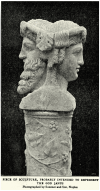Ianus Bifrons: The Two Faces of Metformin
- PMID: 38610965
- PMCID: PMC11011026
- DOI: 10.3390/cancers16071287
Ianus Bifrons: The Two Faces of Metformin
Abstract
The ancient Roman god Ianus was a mysterious divinity with two opposite faces, one looking at the past and the other looking to the future. Likewise, metformin is an "old" drug, with one side looking at the metabolic role and the other looking at the anti-proliferative mechanism; therefore, it represents a typical and ideal bridge between diabetes and cancer. Metformin (1,1-dimethylbiguanidine hydrochloride) is a drug that has long been in use for the treatment of type 2 diabetes mellitus, but recently evidence is growing about its potential use in other metabolic conditions and in proliferative-associated diseases. The aim of this paper is to retrace, from a historical perspective, the knowledge of this molecule, shedding light on the subcellular mechanisms of action involved in metabolism as well as cellular and tissue growth. The intra-tumoral pharmacodynamic effects of metformin and its possible role in the management of different neoplasms are evaluated and debated. The etymology of the name Ianus is probably from the Latin term ianua, which means door. How many new doors will this old drug be able to open?
Keywords: biguanide; cancer treatment; clinical trials; diabetes; glucose control; metformin.
Conflict of interest statement
The authors declare no conflicts of interest.
Figures




References
-
- Naso P.O. Ovidio—Opere. Volume IV. UTET; Torino, Italy: 1999. Fasti I; p. 104.
-
- Hill J. The Vegetable System. Or the Internal Structure and the Life of Plants; Their Parts, and Nourishment, Explained; Their Classes, Orders, Genera, and Species, Ascertained, and Described; in a Methods Altogether New: Comprehending an Artificial Index, and a Natural System. With Figures of All the Plants; Designed and Engraved by the Author. The Whole from Nature Only. Volume 21. Pater-Noster-Row; London, UK: 1772. p. 54. Containing Plants and Four-Petal’d Irregular Flowers.
-
- Hadden D.R. Goat’s rue—French lilac—Italian fitch—Spanish sainfoin: Gallega officinalis and metformin: The Edinburgh connection. J. R. Coll. Physicians Edinb. 2005;35:258–260. - PubMed
-
- Pasik C. Diabetes and the biguanides: The mystery of each. In: Pasik C., editor. Glucophage: Serving Diabetology for 40 Years. Groupe Lipha; Lyon, France: 1997. p. 79.
-
- Rathke B. Uber Biguanid. Ber. Dtsch. Chem. Ges. 1879;12:776–784. doi: 10.1002/cber.187901201219. (In German) - DOI
Publication types
LinkOut - more resources
Full Text Sources
Miscellaneous

